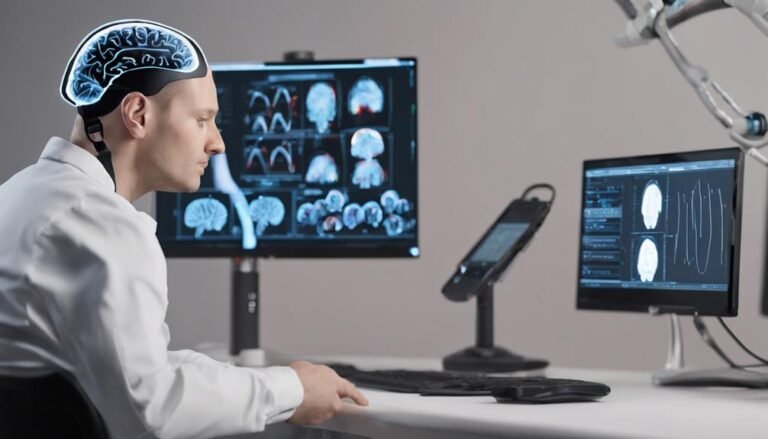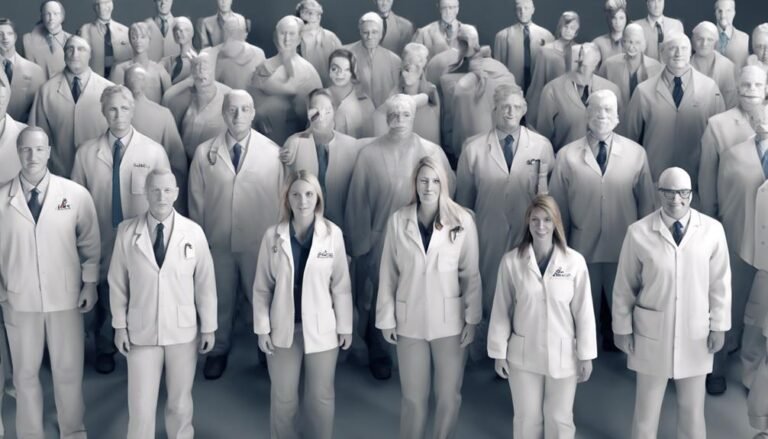Regenerative Medicine Review: The Cutting Edge of Tissue Engineering
Discover the frontier of regenerative medicine and tissue engineering, where groundbreaking strides define the future of healthcare. Stem cells, growth factors, and tissue culture techniques underpin regenerative medicine's backbone. Through biological scaffolds and stem cell therapy, tissues and organs can potentially regenerate. Integration into healthcare and personalized treatments signal a shift towards tailored medical solutions. Challenges like optimizing outcomes and overcoming regulatory complexities remain. Ethical considerations emphasize patient safety and equitable access. Scientific breakthroughs and bridging research with practice are pivotal. Explore the innovative domain of regenerative medicine, where endless possibilities await.
Key Takeaways
- Tissue engineering uses biological scaffolds for cell growth and regeneration.
- Stem cell therapy guides cells to differentiate for tissue repair.
- Regenerative medicine integrates into healthcare for personalized treatments.
- Challenges include optimizing outcomes, regulatory hurdles, and scientific advancements.
- Ethical considerations prioritize patient safety, consent, and equitable access to therapies.
History of Regenerative Medicine
Regenerative Medicine has a rich history that traces back to the early 20th century when scientists first began exploring the concept of tissue regeneration. Development milestones in the field include the discovery of stem cells by Alexander Maximow in 1909, which laid the foundation for understanding the potential of these cells in regenerating various tissues. Further key researchers such as Rita Levi-Montalcini and Stanley Cohen made significant contributions by elucidating the role of growth factors in regulating cell growth and differentiation, important for tissue repair processes.
In the 1970s, the development of tissue culture techniques by Gail Martin and the isolation of embryonic stem cells by Martin Evans and Matthew Kaufman marked significant advancements in regenerative medicine. These discoveries paved the way for the field to explore the potential of stem cells in regenerating damaged tissues and organs. Overall, these development milestones and the work of key researchers have been instrumental in shaping the field of regenerative medicine as it's understood today.
Tissue Engineering Techniques
Exploring innovative tissue engineering techniques involves utilizing advanced biomaterials and cell-based approaches to construct functional biological substitutes for damaged or lost tissues. One key aspect of tissue engineering is the use of biological scaffolds, which provide a framework for cells to grow and develop into functional tissues. These scaffolds can be derived from natural or synthetic materials, offering a supportive structure for cell attachment, proliferation, and differentiation. Another cutting-edge technique in tissue engineering is stem cell therapy, where stem cells are manipulated and guided to differentiate into specific cell types to regenerate damaged tissues. This approach holds great promise for regenerating a wide range of tissues and organs.
| Tissue Engineering Techniques | |
|---|---|
| Biological Scaffolds | Stem Cell Therapy |
| – Provide framework for cell growth | – Manipulate stem cells for tissue regeneration |
| – Support cell attachment and differentiation | – Guide stem cells to differentiate into specific cell types |
| – Derived from natural or synthetic materials | – Regenerate various tissues and organs |
Current Applications in Healthcare
In current healthcare applications, regenerative medicine techniques are being increasingly integrated to address various medical challenges and improve patient outcomes. Clinical trials are pivotal in evaluating the safety and efficacy of regenerative medicine interventions. These trials provide essential data on the potential benefits and risks associated with these innovative treatments. Patient outcomes are carefully monitored throughout these trials to assess the impact of regenerative medicine on improving health conditions.
- Personalized Therapies: Regenerative medicine allows for the customization of treatments based on individual patient needs.
- Organ Regeneration: Techniques such as stem cell therapy hold promise for regenerating damaged or diseased organs.
- Wound Healing: Advanced wound care products derived from regenerative medicine help enhance the healing process.
- Orthopedic Applications: Regenerative techniques are increasingly used in orthopedic surgeries to promote tissue repair and regeneration.
Challenges and Future Directions
Shifting from the current applications in healthcare, challenges and future directions in regenerative medicine revolve around optimizing clinical outcomes and overcoming hurdles in scalability and standardization. Regulatory hurdles pose significant challenges in the widespread adoption of regenerative therapies. To address this, regulatory bodies must adapt to the unique nature of these treatments while ensuring patient safety and efficacy.
Scientific breakthroughs play an important role in advancing regenerative medicine. Research advancements in stem cell biology, tissue engineering, and biomaterials are essential for enhancing the development of innovative therapies. These breakthroughs pave the way for more effective treatments and improved patient outcomes.
Clinical translation remains a key focus for the regenerative medicine field. Bridging the gap between research discoveries and clinical applications is necessary for bringing cutting-edge therapies to patients in need. Standardizing protocols and ensuring reproducibility are crucial steps in achieving successful clinical translation.
Ethical Considerations in Regenerative Medicine
Considering the rapid advancements in regenerative medicine, ethical considerations play a critical role in guiding the responsible development and application of emerging therapies. Ethical dilemmas often arise in regenerative medicine, requiring careful maneuvering to ensure patient safety and autonomy are prioritized.
One of the primary ethical considerations is the need for informed patient consent before undergoing regenerative treatments. Without proper consent, patients may be subjected to risks without fully understanding the potential outcomes.
Additionally, the equitable distribution of regenerative therapies poses a significant ethical challenge, as access to these cutting-edge treatments shouldn't be limited by financial means. Ensuring that vulnerable populations also have the opportunity to benefit from regenerative medicine advances is vital in addressing these ethical dilemmas.
Conclusion
To sum up, regenerative medicine is a rapidly evolving field that holds great promise for the future of healthcare.
Just like a skilled craftsman meticulously repairs a broken vase, regenerative medicine allows scientists to repair and regenerate damaged tissues in the human body.
With advancements in tissue engineering techniques and ongoing research, the possibilities for improving patient outcomes are endless.
As we continue to push the boundaries of regenerative medicine, we're paving the way for a new era of medical treatment.

Our Healthcare Editorial Team is composed of subject matter experts and seasoned healthcare consultants who bring decades of combined experience and a wealth of academic qualifications. With advanced degrees and certifications in various medical and healthcare management fields, they are dedicated to supporting the personal and career development of healthcare professionals. Their expertise spans clinical practice, healthcare policy, patient advocacy, and public health, allowing us to offer insightful, well-researched content that enhances professional growth and informs practice.
Disclaimer
The client education section of our blog is intended to support healthcare providers by offering informational resources for patient education. However, this information is not meant to serve as medical advice. We advise healthcare professionals to ensure all content is consistent with their clinical knowledge and confirm with current medical standards before using it in their practice or advising patients. For specific medical issues, always refer to professional guidance and standards of care.
For any legal matters or specific medical concerns, we strongly recommend consulting with a qualified legal professional or referring to government websites for authoritative information.







